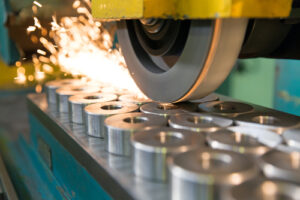 Types of stainless steel finishes are made available after forming for a number of reasons. Though the alloy is well-known for its high corrosion resistance, finishing can provide an added layer of protection against oxidation, corrosion, rusting, and staining. Finishes are also added to meet certain design requirements that may call for an architectural aesthetic, a decorative application, or identification purposes. In other words, finishing is a secondary process. Whatever stainless steel surface finish is selected—for added protection, an aesthetic, or identifier—it serves to further enhance the material’s properties and appearance. Common stainless steel surface finishes are:
Types of stainless steel finishes are made available after forming for a number of reasons. Though the alloy is well-known for its high corrosion resistance, finishing can provide an added layer of protection against oxidation, corrosion, rusting, and staining. Finishes are also added to meet certain design requirements that may call for an architectural aesthetic, a decorative application, or identification purposes. In other words, finishing is a secondary process. Whatever stainless steel surface finish is selected—for added protection, an aesthetic, or identifier—it serves to further enhance the material’s properties and appearance. Common stainless steel surface finishes are:
Passivation
Passivation is a preventive measure that makes metal alloys, particularly stainless steels, more resistant to staining and rusting. Although stainless steel is inherently resistant to corrosion, manufacturing and fabrication processes often leave behind surface contaminants that can inhibit the formation of a uniform oxide layer. If these impurities are not treated they can result in a corrosive reaction. Passivation is not a coating per se, but a treatment process. The metal’s surface is bathed in an acid solution consisting of either citrus acid or nitric acid that draws away and removes any free irons present on the metal surface before that iron can have a corrosive reaction. Additionally, passivation will increase the natural corrosion resistance of other alloys found in stainless steel. Once the surface is treated, other alloys like chromium or nickel react with oxygen to form an oxide layer that further protects the underlying metal surface from staining and rusting.
Electropolishing
Electropolishing is another type of passivation process used by fabricators to polish, treat, and deburr metal parts. An electrochemical solution is applied to the outer layer, or “skin,” of the material’s surface. The process removes microscopic imperfections leaving a uniform layer free of embedded contaminants, micro-cracks, pits, and various surface conditions that could compromise the longevity and performance of a part. Electropolishing can be applied to a wide range of stainless steel grades and provides a lasting bright finish.
Electroplating
Electroplating is a common method to protect steel from corrosion. Unlike electropolishing, which removes the outer skin from the surface, electroplating deposits a thin layer of metal on a material’s surface. Electroplating binds a positively charged metal, usually copper, in a solution that produces a film over the steel’s surface. The method acts to plate the stainless steel with copper. The finishing technique changes the physical properties of the product. It combines the strength of steel with the conductivity of copper, increases the material’s thickness and wear resistance, adds to the corrosion resistance, and offers an aesthetic appeal.
Black Oxide
Black oxide finishing is a blackening conversion coating used on stainless steel and a variety of ferrous metals and alloys. The conversion results from a chemical reaction when the material is immersed in a high-temperature solution. The application provides stainless steel with a surface finish that adds mild corrosion resistance. However, the metal’s surface is left with an aesthetic appearance and, ideally, is applied to meet environmental conditions that minimize light reflection.
Bead Blasting
Bead blasting is an abrasive blasting or sandblasting technique that projects a bead or sphere against a substrate material such as stainless steel to achieve a specific finish on the metal’s surface. Common bead blasting media includes steel shot or glass beads which are shot at high speeds through a machine nozzle over a surface until it is sanded smooth. Glass beads are an excellent choice for stainless steel applications that require a softer, brighter finish, and it has the added benefit of being used multiple times.
Electrolytic Coloring
Coloring stainless steel is accomplished by increasing the depth of the chromium oxide surface layer, which creates distinctive colored effects (much like the phenomenon observed in soap bubbles or oil stains). To color, stainless steel is immersed in a chromic and sulfuric acid solution at a temperature just below boiling. The immersion forms a thin layer of chrome oxide on the material’s surface. Colors varying from bronze to blue, gold, purple and green can be obtained by controlling the thickness of the oxide layer. After immersion, the stainless steel is rinsed and receives a cathodic treatment to harden the oxide layer.
James Spring & Wire Company is a leader in custom spring and wire form manufacturing, engineering, and design. We offer a variety of stainless steel finishing techniques to further enhance products. Whether for increased corrosion resistance and-or design purposes, types of stainless steel finishes will help to protect and identify the parts and components after forming. Ultimately, the type of stainless steel finishing selected depends on the intended post-fabrication application needs or requirements. If you need assistance selecting the appropriate finishing process contact the experts at James Spring & Wire today!

